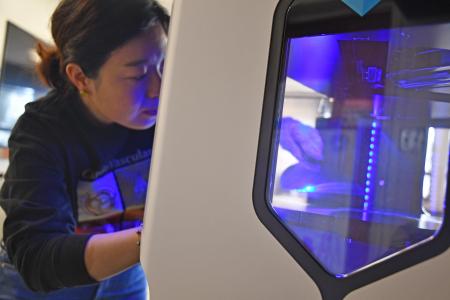Dr. Kelly Suh wins $750,000 grant from the American Heart Association

A team of Engineers and Physicians from CSULB, MIT, Stanford & Providence Medical Center will be working to improve peripheral arterial stents after receiving a 3-year $750,000 grant from the American Heart Association.
Biomedical Engineering Assistant Professor Ga-Young (Kelly) Suh is one of the lead investigators on the interdisciplinary team on their groundbreaking research, “Peripheral Arterial Stents Monitoring Real-Time Dynamics.”
“I feel very blessed. This wouldn’t have been possible without so many people, the Office of Research & Economic Development, the Department, the College,” said Suh. “It was a surprise, and I’ve really gained a lot of confidence.”
This will be the largest external grant that Suh is the lead investigator since joining the College of Engineering in 2019. Before CSULB, she completed her postdoctoral research at Stanford.

“I am so proud to see Dr. Suh in the lead PI role on this exciting grant,” said Dean Jinny Rhee. “The strength of the partnerships she has been able to build for this work is a testament to the strength of her leadership in her field.”
The team aims to address critical challenges in an increasingly important piece of medical technology: the stent.
A stent is a fine-mesh tube placed in an artery of the heart or thigh to keep blood flowing smoothly, known as a coronary or peripheral stent respectively.
Currently, peripheral stents face a major issue that coronary stents do, the heart moves in predictable ways that thighs don’t. Suh and her colleagues hope to add smart-sensor technology that can provide real-time data of the stent’s mechanical stress.

“In a peripheral artery the stress is unpredictable, so it’s much less studied.” explained Suh. “By combing this in-body sensor with current treatments, we hope to drastically improve patient outcomes and quality of life.”
Materials Scientist Jeewan Kim, an associate professor at MIT, is working on the sensor in his lab in Massachusetts.
Once satisfied, the team will test the design in Suh’s lab at The Beach. Suh—along with her students—will 3-D print a phantom leg, mimicking muscle, fat and other tissues, then test the design further.
The grant will allow Suh to bring on more student researchers from several disciplines. Since starting at CSULB, she has also led the CardioVascular Research Club, mentoring undergraduates on multiple biomedical engineering projects.
“For me, students are a big source of joy,” said Suh. “To see them get frustrated by a problem then realize they can solve it, they inspire me.”





